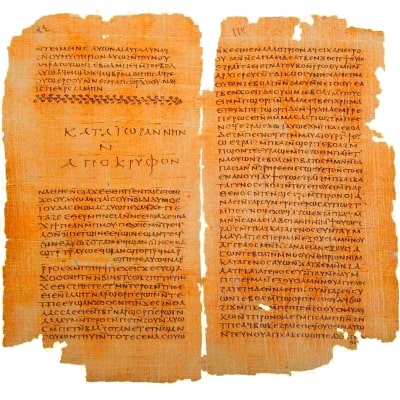Summary | Excerpt | Reading Guide | Reviews | Beyond the Book | Read-Alikes | Genres & Themes | Author Bio

This article relates to The Book of Longings
 Sue Monk Kidd's novel The Book of Longings was in part inspired by a work entitled "The Thunder, Perfect Mind." Narrated by a female divinity, the poem is one of over 50 ancient texts that were found near the town of Nag Hammadi, Egypt, in 1945.
Sue Monk Kidd's novel The Book of Longings was in part inspired by a work entitled "The Thunder, Perfect Mind." Narrated by a female divinity, the poem is one of over 50 ancient texts that were found near the town of Nag Hammadi, Egypt, in 1945.
The tale surrounding the discovery of the works is fascinating in its own right. Several different accounts of how the texts were found have been pieced together from interviews and rumors, but they tend to mostly agree on certain key details: It is generally believed that a farmer named Muhammad 'Ali al-Samman, possibly with one or more of his brothers, was digging for fertilizer when he unearthed a large clay jar and broke it open. Inside were thirteen books, or codices, in Coptic script, which he gathered and took home. His mother burned several pages for fuel, but most were spared and given to the resident Coptic priest for storage. A local teacher happened to see them and sent one book to Cairo to be appraised; it ended up getting sold on the black market, as did several other parts of the cache. The Egyptian Department of Antiquities became aware of the existence of these remarkable works, purchased one and confiscated another ten and a half, and deposited them in the Coptic Museum in Cairo. One volume was smuggled out of Egypt and sold in the U.S., eventually coming to the attention of Professor Gilles Quispel in the Netherlands, who began an investigation of the texts in 1955. The first English translation of the manuscripts was completed in the 1970s by researchers at the Claremont Graduate University in Claremont, California under the direction of religious expert James M. Robinson.
The extant codices in the Nag Hammadi collection contain a total of 52 distinct works or parts of works, many of which are writings that reflect beliefs consistent with Gnosticism, a loose category of religious sects that existed in the early days of Christianity. Beliefs among Gnostics varied widely, but a simplistic interpretation is that they revered knowledge—"gnosis" in the Greek, which refers more to enlightenment than to concrete answers to problems. As the Christian faith coalesced into orthodoxy, Gnostic teachings were deemed heretical and consequently banned; it's thought that the Nag Hammadi writings may have been buried by members of a nearby monastery after a 367 CE church edict forbade the use of non-canonical books.
The Nag Hammadi library contains several early gospels—works that record the life and sayings of Jesus of Nazareth—none of which are considered reliable by most modern Christian churches. Almost all scholars concur that the physical codices were created around the fourth century and that they are copies of earlier works, but there is wide disagreement as to when the documents on which they were based were first composed. One work, "The Gospel of Thomas," is believed by some to have originated as early as 50 CE, which would place it in the same time period as Paul's early letters, and earlier than the generally agreed date of the first of the four officially recognized gospels, "The Gospel of Mark." Another important work, "The Apocryphon of John" (also known as "The Secret Book of John") was denounced by an early church leader named Irenaeus around 180 CE, meaning the text on which the Nag Hammadi copy was based must have been in existence at that time (about 150 years after Jesus's crucifixion).
Other works in the collection offer differing views of well-known Biblical stories; the book known as "The Testimony of Truth," for example, retells the story of Adam and Eve from the viewpoint of the serpent who successfully tempts them with fruit from the Tree of Knowledge. Several documents also speak to the Gnostic concept of Sophia (divine wisdom and the feminine aspect of God), including "The Thought of Norea," "The Sophia of Jesus Christ," "The Exegesis on the Soul" and "The Thunder, Perfect Mind."
The original Nag Hammadi codices are housed in the Coptic Museum in Cairo, Egypt, but translations are available online, in print and in ebook format.
Filed under Cultural Curiosities
![]() This "beyond the book article" relates to The Book of Longings. It originally ran in May 2020 and has been updated for the
March 2021 paperback edition.
Go to magazine.
This "beyond the book article" relates to The Book of Longings. It originally ran in May 2020 and has been updated for the
March 2021 paperback edition.
Go to magazine.






Your guide toexceptional books
BookBrowse seeks out and recommends the best in contemporary fiction and nonfiction—books that not only engage and entertain but also deepen our understanding of ourselves and the world around us.